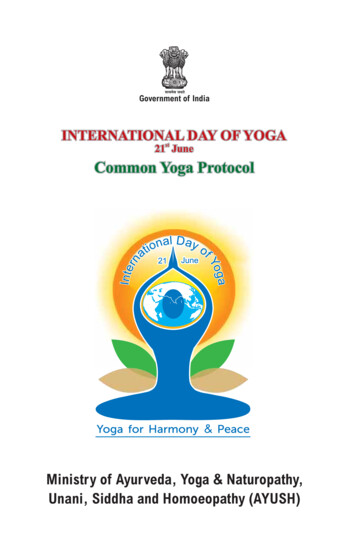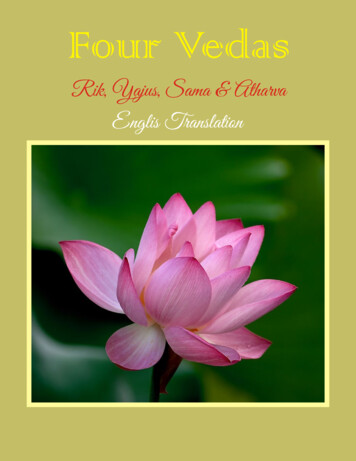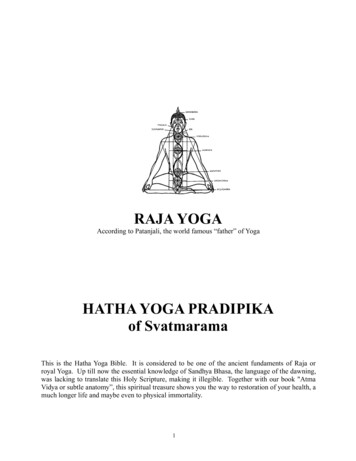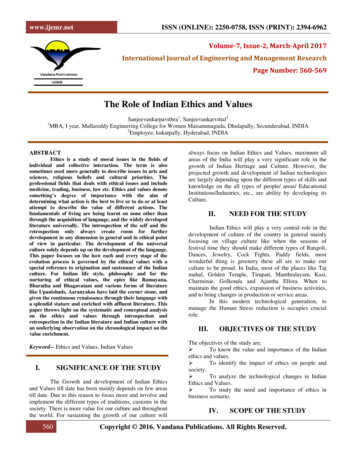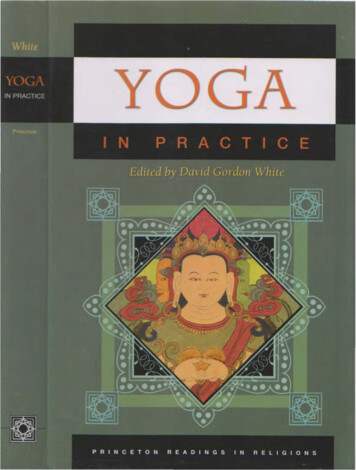
Transcription
Samkhya PhilosophyYoga Veda Institute
Samkhya PhilosophyIntroduction to SamkhyaÄyurveda is literally translated as ‘Knowledge of Life’. So, even though thisknowledge may be scientific, it is also very much a philosophical view of life.There are six major philosophical views, or perspectives in India. Think of itas an object, which can be viewed six di erent ways- you can have a frontalview, back view, birds eye view, a long distant view, an extreme close up, andso on. Similarly, Knowledge and Life can also be seen with di erentperspectives. In India, it’s re ered to as the Shad Darshan {the sixphilosophies of life}.These six perspectives or philosophies, whereby, we view or experience ‘life’are: Samkhya {Theory of creation, Duality and Enumeration} Seer Kapila Muni Nyaya {Logic and Reasoning} Seer Gautama Rishi Vaisheshika {Unique Aspect} Seer Kanada Mimasa {Ritual} Seer Jaimani Yoga {Union – practical application of Sankhya} Seer Patanjali Vedanta {Study of Veda Sutras} Seer Veda VyasaIn this program we are focusing on Samkhya, and Vedanta. Among these sixperspectives and philosophies Äyurveda has been in uenced most bySamkhya. There have been in uences from other philosophies likeMimamsa, Yoga and Vedanta as well.
Samkhya PhilosophyDefinition of SamkhyaSamkhya Philosophy translates as “Theory of Numbers or Enumeration” andsubtle principle of energies that govern the universe, and all the livingentities. It is impossible to understand Äyurveda without understandingSamkhya Philosophy.Mentions of Samkhya are found in various ancient texts, however, we willfocus on ‘Bhagavata Purana’ and teachings of Kapila, and Caraka Samhita.Samkhya is one of the six perspectives or philosophies that in uencedÄyurveda. The founder of Samkhya Philosophy is Sage Kapila. According tosage Kapila, The desire to create and procreate is a natural instinct withinevery one of us. The reason behind is the universe itself. Universe createdus. And, being a part and parcel of the universe – we have the same desire.Just like in the Dao symbol, we have the yin and yang – male and female part– two sides of a same coin. Similarly the energy of the universe also has twosides. There is Purusha and then there is Prakruti. The Male Divine orPurusha has a desire to witness himself through the creative potential of hisown feminine energy, the Prakrati. After the ‘divine’ breathed OM and thusthe duality of the ego {being male and female} into life.Creation of universe ultimately originates within the divine love betweenpurusha and prakrati and their desire to manifest that love. SamkhyaPhilosophy is the theory of the creation of universe through 24 subtleelements.
Samkhya PhilosophyIn order to, understand Äyurveda, it is important to grasp an understandingof Samkhya Philosophy. There are many di erent explanations of SamkhyaPhilosophy. The explanation of samkhya here, may be slightly di erent fromother explanations that you have read, or heard. It is based on thedescription of Samkhya described in the ancient text, called BhagavadPurana.Samkhya is an understanding of the universe and the way that we t into itby understanding how the gross elements have evolved from more subtleones. Subtle principles a ect other principles in day to day life. Äyurvedarecognizes that sometimes subtle energies or functions of consciousnesscan sometimes play an extremely important role in how we becomediseased. This explanation of samkhya is very much connected toexplanation of Shakti (Universal Divine Energy or Source – Female), andShaktiman (Divine Source – Male), as given in Vedanta. (Ancient ScripturalTexts). Shakti means power or energy. Shaktiman is the wielder of power.According to Vedanta, There is only ONE powerful personality (the source ofall creation). That personality is referred to as ‘PURUSHA’ in SamkhyaPhilosophy. Creation begins from the perspective of Samkhya philosophywith two concepts. First, is the concept of Purusha – who is the enjoyer orthe predominator, and, the second, is the concept of ‘Prakrati’ or Matter.When we say in Samkhya philosophy, we are talking about matter in itsoriginal, balanced, equipoised state. When the Purusha glances over Matterin its original state, life is injected into it.We can say, it is something like – God has breathed life into the universe, asdescribed in the Bible. So, Purusha is the energetic, the wielder of power.And,Prakrati is ENERGY. Energy in the form of potential of all other mattersand forms of energy. It transforms into other forms of life. From Vedanta wealso understand that this ENERGY also exists as ‘self’.
Samkhya PhilosophyUnderstanding the SELF is critical in order to understand that which makesa distinction between living body and a dead body. In a dead body, allfunctions of bodily actions have stopped. There is no breathing, no brainactivity, no heart activity. We say, someone has died. But, according toVedanta and Samkhya, it is the presence of the self within the body thatmakes the distinction between living and self. So, Samkhya will say SELF hasleft the physical body, instead of someone has died. Nonetheless, We arenot talking about body and mind, and self conception. These are describedseparately.When we talk about SELF we mean SOUL, JIVATMA in sanskrit, that spiritualself that exists within all coverings like mind, intellect, ego and gross andsubtle forms of body.An Overview of Universe as viewed by SamkhyaIn Samkhya there are two main principles – Purusha and Prakrati. Samkhyais a way of understanding the universe through the principles of subtleenergies and their interactions de ned in ancient text called ‘BhagavadPurana’, which is related to the understanding of shakti (power) andshaktiman (powerful). In Samkhya philosophy, there is only one Source – AMale Divine, who is equivalent to Purusha (predominator or wielder ofenergies), who energizes the Prakruti which is equivalent to shakti. AsPurusha breathes life into nature, the energy or nature manifests as jivatma(soul) in the Äyurvedic sense of “self” – all these other elements are created.The principle of Pancha Mahabhoota is closely related to the Samkhyaphilosophy as it develops it’s system on the 5 basic subtle elements (space,air, fire, water, earth) that together compose the life energy (prakruti).
Samkhya PhilosophyÄyurveda de nes 3 types of prakruti (Doças) based on the 5 basic elements:Kapha (Water and Earth), and Pitta (Fire), Vata (Air and Space/Ether). We areborn with a combination of these 3 elements and our constitution (prakruti)is determined by the dominant element(s). When the three Doças arebalanced, a human is considered to be in a perfect health in the Äyurvedichealth science. When, anyone of these elements is imbalanced and/orimpaired, it is believed that it creates disease.These three elements create the seven Dhätus (Sapta Dhätu) that give shapeto the body. Everyone is born with a combination of the three elements.However, one element is dominant and is called the constitution or Prakratiof the person, and one’s constitution determines the primary cause of one’sailments.We are controlled by three modes of nature, called Mode of Goodness(Sattva), Mode of Ignorance (Rajas) and Mode of Passion (Tamas). Everyaction or karma is governed by these three modes.According to Äyurveda, these seven Dhätus are chyle, blood, esh, fat, bone,marrow, and semen. Kapha (earth/water) controls blood, fat, marrow andsemen. Vata (air) controls bones and joints. Pitta ( re) controls the ‘Agni’ thataids digestion. Vata or VÄyu (air) is responsible of the entire movement ofthese Dhätus.
Samkhya PhilosophySamkhya Philosophy in ReviewAyurveda is based on one of the six philosophical perspectives calledSamkhya. Samkhya theory was given by Sage Kapila. This theory gives anexplanation on the origin of universe and life. It o ers a model of evolvingconsciousness from non-material to material. It regards the universe to beconsisting of two realities: Purusha (consciousness) and Prakriti (unmanifested/matter). Both the “Purusha” and “Prakriti” are completelydistinct, yet, connected. Purusha is uncreated, absolute, pure and passivewitness to creation whereas Prakriti is dynamic, creates, impure and which isthe first principle of manifestation. It contains 3 gunas-Rajas, Tamas, Sattva.Prakriti is the force that works like automation. All the cause and e ect arealready latent in it. When the Purusha and Prakriti comes in contact witheach other, the equilibrium of the 3 gunas break which results inmanifestation of Mahad (Buddhi) which further manifests intoAhamkara(Ego) which activates the trigunas. The action of Rajas on Tamasresults in, 5 tanmantras and pancha mahabhutas. These mahabhutas resultin the tridoshas of Vata, Pitta and Kapha. The action of Rajas on Sattva givesrise to 5 knowledge acquiring senses and the five working senses.
Yoga {Union - practical application of Sankhya} Seer Patanjali Vedanta {Study of Veda Sutras} Seer Veda Vyasa In this program we are focusing on Samkhya, and Vedanta. Among these six perspectives and philosophies Äyurveda has been in8uenced most by Samkhya. There have been in8uences from other philosophies like
